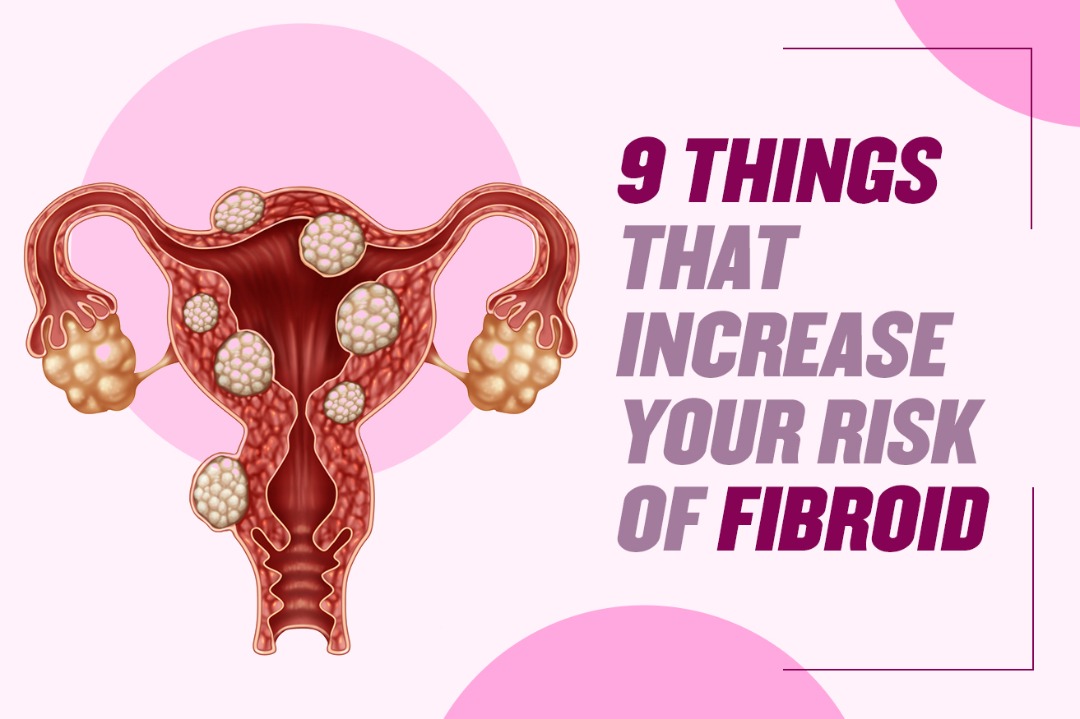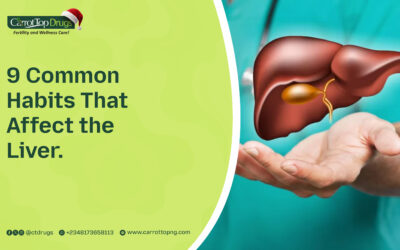Introduction
Uterine fibroids are noncancerous growths that develop in the uterus, affecting millions of women worldwide. In this article, we will explore the things that can increase the risk of uterine fibroids in women. Understanding these risk factors is crucial for early detection, prevention, and effective management of this condition.
Understanding Uterine Fibroids
Definition and Overview
Uterine fibroids, also known as leiomyomas, are benign tumors that originate from the smooth muscle tissue of the uterus. They can vary in size, ranging from small, undetectable nodules to large masses that distort the shape of the uterus. Fibroids can develop within the uterine wall. It can also protrude into the uterine cavity, or attach to the outer surface of the uterus.
Prevalence and Impact
Uterine fibroids are incredibly common, with research indicating that up to 70-80% of women may develop them by the age of 50. While many women may not experience any symptoms, fibroids can cause significant discomfort and complications in some cases. Symptoms may include:
- heavy menstrual bleeding,
- pelvic pain,
- pressure on the bladder or rectum,
- and reproductive issues such as infertility or recurrent miscarriages.
Risk Factors for Uterine Fibroids
Genetics
Genetic predisposition can significantly increase the risk of developing uterine fibroids. Certain genes have been associated with an elevated likelihood of experiencing this condition. Studies have indicated that a family history of uterine fibroids can substantially raise the risk for an individual. Inherited genetic mutations or variations can predispose individuals to develop fibroids, highlighting the importance of understanding one’s family medical history.
Among the genes associated with uterine fibroids, several key candidates have been identified through genetic studies and research. For instance, variations in genes involved in estrogen metabolism, such as the estrogen receptor gene (ESR1) and mediator complex subunit 12 (MED12) gene, have been linked to an increased risk of fibroid development. Additionally, genes encoding proteins involved in cell proliferation and growth, such as the fibroblast growth factor (FGF) genes, may also play a role in fibroid formation.
Age
Age is a significant factor that can increase the risk of developing uterine fibroids in women. As women age, especially as they approach menopause, the likelihood of experiencing fibroids tends to rise. This association between age and fibroid risk can be attributed to various hormonal changes. Estrogen and progesterone are closely linked to fibroid growth and they fluctuate throughout a woman’s life. Their levels typically peak during the reproductive years. Therefore, age is considered one of the things that can increase the risk of uterine fibroid.
Obesity
Obesity is recognized as a significant risk factor for developing uterine fibroids in women. As adipose tissue, or fat cells, produce estrogen, excessive body weight can lead to higher levels of estrogen in the body. Elevated estrogen levels have been associated with the growth and development of uterine fibroids. Therefore, obesity is considered one of the critical things that can increase the risk of uterine fibroid. Women who are overweight or obese may have a higher likelihood of experiencing fibroids due to the hormonal imbalances caused by excess body fat.
Furthermore, obesity is often linked to other comorbidities such as insulin resistance and metabolic syndrome. These conditions can further exacerbate hormonal disruptions, creating an environment conducive to fibroid growth. Insulin resistance, in particular, may lead to higher insulin levels in the body, which can stimulate the production of estrogen and other hormones that promote fibroid development. Therefore, addressing things that can increase the risk of uterine fibroids, such as obesity and its associated metabolic conditions, is essential for managing fibroid risk and promoting overall health.
High Blood Pressure
High blood pressure is another significant risk factor associated with the development of uterine fibroids in women. It can lead to vascular changes and disruptions in blood flow. This may contribute to the growth and progression of uterine fibroids. Elevated blood pressure levels can impact the delicate balance of estrogen and progesterone, which are known to influence fibroid growth. Therefore, high blood pressure is considered one of the critical things that can increase the risk of uterine fibroid.
Nulliparity
Nulliparity, or the condition of never having given birth to a child, is recognized as a significant risk factor for the development of uterine fibroids in women. Research suggests that pregnancy and childbirth may have protective effects against fibroid formation. Another research by Shannon K Laughlin et al revealed that higher parity is associated with reduced fibroid risk making nulliparity one of the critical things that can increase the risk of uterine fibroid.
Vitamin D Deficiency
Vitamin D deficiency is emerging as a potential risk factor for the development of uterine fibroids in women. Research suggests that inadequate levels of vitamin D may contribute to hormonal imbalances and inflammatory processes that promote fibroid growth. Vitamin D plays a crucial role in regulating immune function, cell growth, and hormone production, all of which are implicated in the pathogenesis of uterine fibroids. Therefore, vitamin D deficiency is considered one of the critical things that can increase the risk of uterine fibroid.
Furthermore, vitamin D receptors are present in various tissues throughout the body, including the uterus. Insufficient vitamin D levels may compromise the normal functioning of these receptors, leading to dysregulation of cell proliferation and apoptosis in the uterine tissue. Addressing things that can increase the risk of uterine fibroid, such as vitamin D deficiency, through supplementation like Evergreen Vitamin D3 and adequate sun exposure, is essential for maintaining optimal vitamin D status and supporting overall uterine health.
Excessive Consumption of Food Additives
The consumption of food additives is increasingly recognized as a potential risk factor for the development of uterine fibroids in women. Many processed foods contain additives such as preservatives, artificial sweeteners, and flavor enhancers, which may have adverse effects on hormonal balance and reproductive health. Certain food additives have been linked to disruptions in endocrine function, including alterations in estrogen metabolism and activity. Therefore, the regular consumption of foods high in additives is considered one of the critical things that can increase the risk of uterine fibroid.
Excessive Consumption of Red Meat
Regular consumption of red meat is considered one of the critical things that can increase the risk of uterine fibroid. Some studies have suggested that the high fat content in red meat may influence estrogen levels in the body. Excess dietary fat can stimulate the production of estrogen, leading to hormonal imbalances that promote the growth of uterine fibroids. Additionally, certain compounds present in red meat, such as heterocyclic amines and polycyclic aromatic hydrocarbons, formed during the cooking process, have been linked to increased estrogenic activity and inflammation.
Excessive Alcohol Consumption
Excessive alcohol consumption is associated with increased estrogen levels and decreased progesterone levels, hormonal imbalances that have been linked to fibroid development. Therefore, alcohol consumption is considered one of the critical things that can increase the risk of uterine fibroid.
Furthermore, alcohol metabolism can generate reactive oxygen species (ROS) and oxidative stress, which may damage cells and tissues in the body, including the uterine muscle cells. Chronic oxidative stress has been implicated in fibroid pathogenesis, as it can promote inflammation, cell proliferation, and fibrotic changes in the uterine tissue.
Early Menstruation
Early onset of menstruation has been identified as a potential risk factor for the development of uterine fibroids in women. Girls who experience menarche before the age of 11 or 12, may develop fibroids later in life. Early menarche is associated with higher cumulative exposure to estrogen, as the ovaries begin producing this hormone earlier in the menstrual cycle. Increased estrogen exposure during puberty and adolescence can stimulate the growth and proliferation of uterine muscle cells, potentially leading to the formation of fibroids. Therefore, early menarche is considered one of the critical things that can increase the risk of uterine fibroid.
Low Consumption of Fruits and Vegetables
Not consuming enough green vegetables can significantly increase the risk of developing uterine fibroids in women. Green vegetables, such as spinach, kale, broccoli, and collard greens, are rich in essential nutrients, vitamins, and antioxidants. These play a crucial role in maintaining hormonal balance and supporting overall reproductive health. They are abundant in vitamins A, C, and K, as well as folate, magnesium, and fiber. All of these are important for regulating hormone levels, reducing inflammation, and promoting detoxification processes in the body. Therefore, inadequate consumption of green vegetables is considered one of the critical things that can increase the risk of uterine fibroid.
Smoking
Smoking has been identified as a significant risk factor for the development of uterine fibroids in women. Cigarette smoke contains numerous toxic chemicals, including nicotine and carbon monoxide, which can disrupt hormonal balance and impair reproductive health. Nicotine, in particular, can constrict blood vessels and reduce blood flow to the uterus, compromising the delivery of oxygen and nutrients to uterine tissues. This vascular dysfunction may contribute to the growth and progression of uterine fibroids. Therefore, smoking is considered one of the critical things that can increase the risk of uterine fibroid.
Furthermore, smoking has been linked to increased oxidative stress and inflammation in the body. These are both implicated in fibroid pathogenesis. Therefore, smoking cessation and reducing exposure to cigarette smoke are crucial steps in addressing things that can increase the risk of uterine fibroid and promoting overall reproductive well-being.
Conclusion
Understanding fibroid risk factors is essential for women’s health. Genetics, hormones, diet, and lifestyle matter. Interventions like diet changes reduce risk. Awareness and prevention improve quality of life.
FAQs
- What are uterine fibroids?
- Uterine fibroids are noncancerous growths that develop in the uterus.
- What causes uterine fibroids?
- The exact cause is unknown, but factors like hormonal imbalances and genetic predisposition may play a role.
- What are the symptoms of uterine fibroids?
- Symptoms can include heavy menstrual bleeding, pelvic pain, frequent urination, and abdominal pressure.
- Can uterine fibroids affect fertility?
- In some cases, uterine fibroids can affect fertility, depending on their size and location.
- How are uterine fibroids diagnosed?
- Diagnosis is typically made through a pelvic exam, ultrasound, MRI, or other imaging tests.
- What are the treatment options for uterine fibroids?
- Treatment options include medication, minimally invasive procedures, and surgery, depending on the severity of symptoms and individual preferences.
- Can uterine fibroids go away on their own?
- In some cases, uterine fibroids may shrink or disappear without treatment, especially after menopause.
- Are uterine fibroids cancerous?
- Uterine fibroids are almost always noncancerous, but they should be monitored by a healthcare provider.
- Can lifestyle changes help manage uterine fibroids?
- Yes, maintaining a healthy weight, exercising regularly, and reducing stress can help manage symptoms and reduce the risk of fibroid growth.
- Is pregnancy possible with uterine fibroids?
- Yes, many women with uterine fibroids are able to conceive and have successful pregnancies, although some may require medical intervention or monitoring.

















